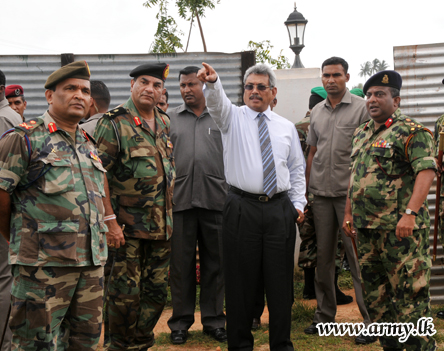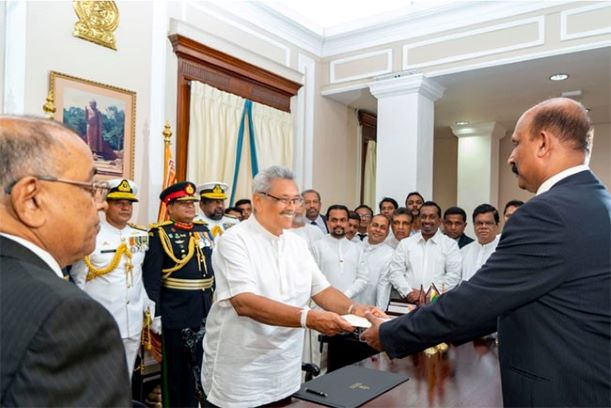Crushing LTTE: Gotabaya’s armed forces shape up
Posted on September 14th, 2020
By P.K. Balachandran/Ceylon Today Courtesy NewsIn.Asia
The inspiring story of the Sri Lankan armed forces’ make over done by Defense Secretary Gotabaya Rajapaksa is told in a gripping way by the current Defense Secretary Maj.Gen.(Rtd) Kamal Gunaratne.

Colombo, September 14: In 2005, when Gotabaya Rajapaksa took over as Sri Lanka’s Defense Secretary at the request of the newly elected President Mahinda Rajapaksa, the country’s armed forces were in a depleted, ill-equipped and dispirited state. They were being outwitted and outmaneuvered by the intrepid and innovative LTTE.
The Lankan Army, Navy and the Air force were short of manpower and suitable equipment. Their strategies and tactics were ill-suited to the new challenges posed by the LTTE, which kept coming up with innovations in asymmetric warfare to the discomfiture of the Lankan tri-forces.
Successive Governments contributed to the mess by their lackadaisical policies on war and peace, and by being subservient to external powers that poked their noses with their own ends in view. Adding insult to injury, a Sri Lanka which was battling for survival was being hammered internationally for denying minority and human rights.
But come Gotabaya Rajapaksa to the helm as Defense Secretary, a sea change occurred in strategy, tactics, manpower, leadership, training and equipment. With the full backing of President Mahinda Rajapaksa and Treasury Secretary Dr. P.B. Jayasundera, Lanka’s demoralised armed forces were energised to the optimum. Continuous battlefield successes boosted troop morale and helped increase recruitment.
Gotabaya’s strategy of shelving the defensive approach and replacing it by an uninterrupted and multi-pronged assault on the enemy sealed the fate of the LTTE in less than three years.
How all this was done is related in a gripping way by Major General Kamal Gunaratne, a former field commander and the present Defense Secretary, in his new book Gotabaya” published last week by VijithaYapa.
Army
That the Army, the main armed force, was under-manned was known for quite some time. Gotabaya knew that successive Governments feared that the country would not be able to afford a large Army. But he was convinced that spending adequately on men and material now would result not only in the elimination of the scourge of terrorism but also save money for the country by ridding it of recurring war expenditure and a prolonged disruption of the economy.
But convincing the decision makers was not easy. President Rajapaksa and Treasury Secretary Jayasundera subjected Gotabaya to searching questions but were soon won over by the force of Gotabaya’s arguments. General Gunaratne notes that the rapport between the trio was so good that never once did Gotabaya return empty handed from the weekly Defense Council meetings.
The Army size was increased immediately from 70,000 to 120,000 and eventually to 300,000. This helped it conduct multi-pronged and continuous operations to hem in and crush the LTTE. Gotabaya even got the much smaller and expensive equipment-dependent Navy and Air force to recruit an extra 10,000 and 5,000 men respectively,so that these men could help hold captured territory while the Army kept going on the offensive. Thanks to the Api Venuven Api propaganda offensive launched by Gotabaya to instill pride in soldiering, recruitment burgeoned.
Choosing Army Chief
The other important task was to get a suitable Amy Commander. Gotabaya felt that Major General Sarath Fonseka was the kind of pushy and hard as nails type he wanted at the helm in place of the incumbent Lieutenant General Shantha Kottegoda. But there were three issues: Kottegoda was a friend and Mahinda wanted him to complete his term. Besides, Fonseka was on the verge of retirement. But the goal-oriented Gotabaya would not let these factors stand in his way. He got Fonseka, and Mahinda compensate Kottegoda by sending him off as Ambassador to Brazil. After the change of guard, Gotabaya, in consultation with Fonseka, changed personnel at various levels based on competence rather in place of seniority.
The next item on Gotabaya’s agenda was to see that India did not interfere and stop the war as it did in 1987 when it stopped the Vadamarachchi operation and saved the LTTE from an early death. He contacted the Indian High Commissioner Alok Prasad and suggested the formation of a Troika” of very senior Indian and Sri Lankan officials to coordinate relations.
Due to the close cooperation fostered by the Troika, the Mahinda Rajapaksa Government was able to conduct the war uninterrupted till the end, whilst maintaining cordial relations with India,” General Gunaratne writes.
Gotabaya got the Army Infantry Fighting Vehicles (IFV) so that they could move speedily and without being killed by enemy fire. He also got Baktar Shikan missiles from Pakistan and Green Arrow missiles from China to destroy LTTE positions from more than a kilometer away. Five Chinese radars were secured to pin point enemy targets for the Army’s guns.
To eliminate middlemen, streamline purchases and cut out corruption, the Defense Secretary set up Lankan Logistics and Technologies. In an earlier era, due to middlemen in cahoots with politicians, the forces were issued American M16s assault rifles in preference to T-56s, though the former was more expensive and had failed to perform under Sri Lankan climatic conditions. Later the M16s were replaced by the cheaper and better performing T-56s. When the Army asked for Russian Armored Personnel Carriers with a 30 mm cannon, the Government got Chinese T063 2 APCs with only a medium machine gun. Centralised purchases by Lanka Logistics helped end inappropriate buying of that sort.

Air Force
The Air force too was poorly quipped and under-manned. Its men were not trained to handle modern equipment. It needed a huge upgrade”. Since most of the serviceable aircraft were old, their ability to stay in the air was limited which affected their combat usefulness. Ground troops expecting air support were often disappointed with help from the Air force.
Gotabaya knew that equipping the Air force or Navy was going to be very costly. But with the cooperation of Treasury Secretary Dr. Jayasundera, Gotabaya bought four new MiG-27 ground attack aircraft and sent four grounded MiG -27s overseas for overhauling. All the Kfir fighters were sent for overhauling. With the help of techno-savvy Air Chief Air Marshal Roshan Goonetileke, Gotabaya secured Unmanned Aerial Vehicles (UAV) for pin point target spotting and reconnaissance of enemy territory. He got laser guided bombs for ground attack aircraft. An integrated UAV and ground located monitoring system enabled sharing of real time intelligence. To train pilots and airmen, Gotabaya imported Chinese trainer aircraft.
Navy
Though Sri Lanka is an island, and the LTTE was getting sustenance from and shelter in Tamil Nadu across the Palk Strait, successive Lankan Governments did not take the Navy seriously. Dvora Fast Attack Craft were acquired from Israel but soon the LTTE Sea Tigers ungraded themselves to be a potent combat force” using fast and better gunned craft and also suicide boats. Navy chief, Admiral Wasantha Karannagoda, was asked what he wanted immediately. Karannagoda said he wanted increased fire power and a gun system which could fire accurately when the vessel was being tossed about. The stabilised fire control system” was expensive but Gotabaya sanctioned its purchase and also got this and other equipment made locally. The request for 30 mm guns in place of the 25 mm guns were granted to enable Navy vessels to fire from a greater distance. To relieve the Navy of the burden of ferrying troops and civilians between the North and the South, Gotabaya used a passenger vessel Jetliner”.
Fonseka vs Karannagoda
While the Army and the Navy were improving their performance by leaps and bounds, there was one insurmountable problem before Gotabaya – the unseemly quarrel between Army Commander Fonseka and Navy chief Karannagoda. They were both from the same school, Ananda College, and were friends there. But as commanders they could not see eye to eye. At one point the Army and the Navy were poised for an armed battle with each other on Mandaithivu island which was prevented only by Gotabaya’s intervention, General Gunaratne recalls.
When all else failed, Gotabaya resorted to spiritual intervention and invited the two warring chiefs to a sermon by Ven Uduwe Dhammaloka Thero at Temple Trees. But this too had no effect. Finally, Gotabaya gave up. But he saw to it that at every other level, the Army and the Navy cooperated. Admiral Karannagoda told General Gunaratne later that Gotabaya should be given an award for managing the antagonism and preventing it from affecting the war effort in any way.